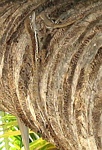 |
| - |
| |

|
- |

|
These pictures illustrate
how lizards may camouflage
themselves with their surroundings. The dewlap
protruding from under the neck (above) was probably a
hint at him defending his territory as I edged closer
but he soon retreated to rely on his camouflage for cover. |
|
| - |
|
|
|
The
lizard, 2nd to the right above, is distinctly different
to the other tree lizards. Its skin is a single
color that lacks any striking patterns. It was
found mainly around building but is obviously
not a house gecko. |
|
|
| -Natural Selection |
|
The lizard may be found in
gardens and in the wild throughout Anguilla. and tends to
feed on ants and other small insects. |
|

|
| - |
|
These
two tree lizards, photographed mating, allows for a clear
comparison of the size difference between the male and
female. |
|

|
| - |
|